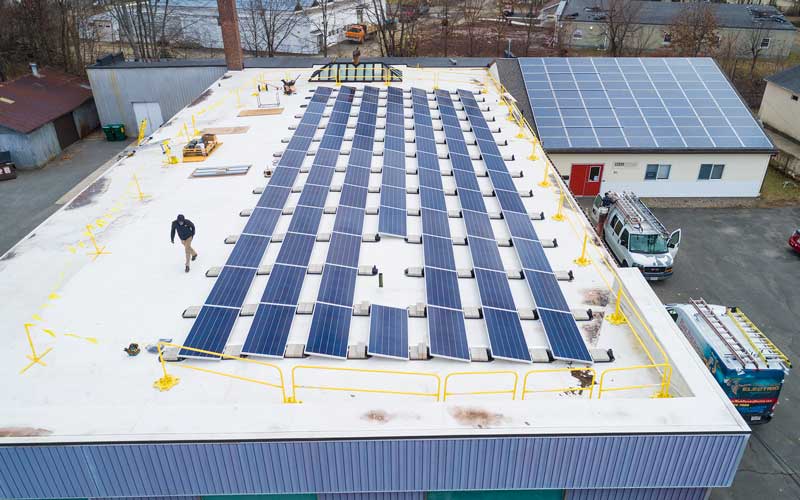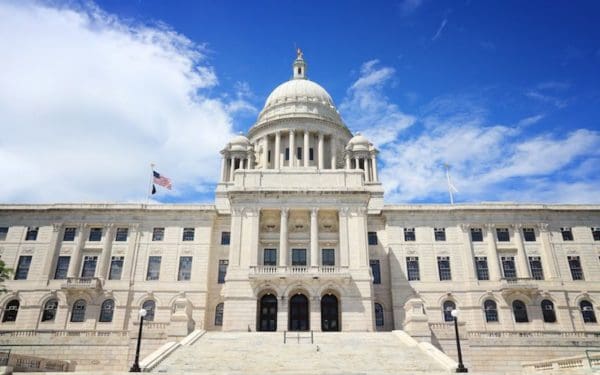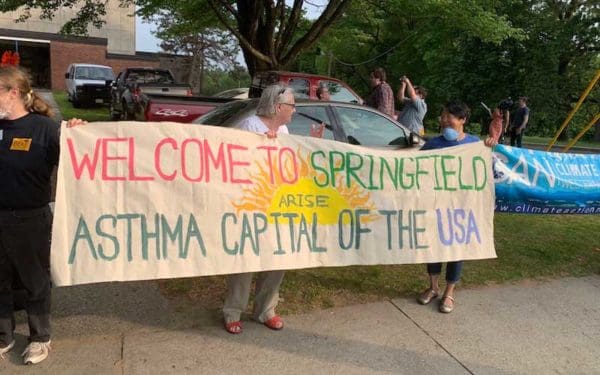
Large-scale solar panel installations can form a key component of microgrids. Photo: EcoPhotography
As climate change has made extreme weather more common over the past few years, we’ve seen the grim impact on our aging power infrastructure. Hurricanes, blizzards, wildfires, and even simple heat waves have triggered devastating blackouts in every corner of the country. How can we protect ourselves from losing power while weaning ourselves off the fossil fuels causing the climate crisis? Microgrids, which provide energy independence to small communities, could provide part of the solution. CLF is fighting to make microgrids more accessible in Massachusetts.
What are microgrids?
A microgrid is a small network of electricity users – like a hospital, a school, and homes – connected to a local source of energy, such as solar panels or geothermal energy, and often a form of storage such as a battery. A microgrid can connect or disconnect from the broader energy grid, so it can operate independently and keep the lights and heat on, even if the broader grid experiences an outage.
Microgrids can take a wide variety of forms. For example, a residential community could pool the energy from home-based rooftop solar with that generated by a field of solar panels to become a self-sustaining microgrid. Another model could include a hospital complex and nearby commercial buildings powered by wind turbines, or a university community that receives power and heat from geothermal energy.
How are microgrids good for the environment?
Many microgrids run on renewable energy. Solar panels, wind turbines, and geothermal power are common sources of energy. Microgrids take the strain off of regional electrical grids, decreasing the need to resort to dirtier sources of energy in times of high need. Some microgrids generate so much power that they can sell it back to the centralized electric grid, turning a profit for participants while increasing the reach of renewable energy sources.
Microgrids are also more efficient than traditional energy infrastructure. Different buildings have different needs, and a contained microgrid can distribute energy more intelligently than a sprawling electric grid. For example, commercial office buildings that require most of their power from nine to five can complement residential buildings that use more power in the early morning and evening. Additionally, less energy gets lost in transit, since it simply has far less distance to travel. In traditional models, around 5% of energy is lost in transmission.
How do microgrids benefit people?
Power outages aren’t fun for anyone – no one likes sweating in an un-air-conditioned bedroom or shivering in layers of sweaters in the dark – but the effects fall harder on some people than others. People with disabilities and chronic medical conditions may find themselves without vital medical equipment or access to medication needing refrigeration. Losing your air conditioning and electric fans is more dangerous if you’re already living in a community suffering from excessive heat. Families with fewer resources have a harder time taking refuge elsewhere, replacing food that spoils, or covering other related costs. Environmental justice communities in Massachusetts are also more likely to have electricity disrupted for longer periods than other communities.
Microgrids have the potential to make vulnerable communities more resilient in the face of climate change. Blackouts cause an estimated $150 billion in damage to communities every year. As extreme weather batters our outdated utility infrastructure, this number will likely rise. Microgrids, particularly in strategic areas, could help. As they are adopted more widely, it’s vital that access to this valuable resource is equitable. For example, Indigenous communities are often under-resourced, rural, and/or isolated, making them great candidates for the energy independence microgrids can bring. We could see the greatest benefits from installing microgrids where they’re needed the most.
Microgrids can also keep crucial infrastructure up and running in an emergency. Hospitals, first responders, and emergency services using a microgrid don’t need to worry about relying on fallible and expensive generators. Military bases that use microgrids are less vulnerable in a crisis.
How can we increase the number of microgrids?
Currently, microgrids can be expensive to set up and run, though key technologies like batteries and solar panels are improving and coming down in price. Typically, multiple parties have to agree to shoulder the costs, which creates added challenges. Government funding could solve this problem. The U.S. Department of Energy’s Office of Electricity recently announced $14.7 million in funding for microgrids in underserved and Indigenous communities. This is a great start, but much more investment is needed.
Complicated utility laws and regulations can also create hopeless snarls of red tape in the path of microgrids. Communities with fewer resources are the least likely to be able to disentangle them. More transparent and supportive policies regarding microgrids are badly needed to clear a path for wider adoption.
For example, the city of Chelsea, Massachusetts, planned a microgrid that would support City Hall, the 911 dispatch center, the police department, and a low-income housing complex with solar panels. In the process, they discovered that sharing power across property boundaries violated utility companies’ legal right to a monopoly. They ultimately found a creative workaround to store and distribute power, but the delay cost them valuable time and money. We should be shaping policy to encourage energy independence, not stymy it.
That’s why CLF is pushing to make it easier for communities across New England to create microgrids and achieve sustainable energy independence. In Massachusetts, for example, utility companies currently have so much legal control over the distribution of energy that they can often veto proposed microgrids. We’re pushing for legislation in the Commonwealth that will protect towns’ and individuals’ right to develop microgrids without interference from electric and gas companies. More microgrids will create an electrical grid that is stronger, more resilient, and more sustainable. We shouldn’t wait to adopt this valuable tool for both fighting climate change and protecting people from its impacts.



